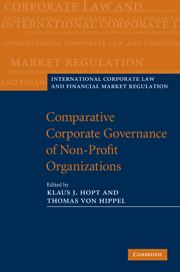Book contents
- Frontmatter
- Contents
- List of contributors
- Preface
- Abbreviations
- PART I Economic findings and theories on nonprofit organizations
- PART II The nonprofit sector: private law, trust law, tax law in selected countries
- PART III The board of nonprofit organizations
- 8 The board of nonprofit organizations: law and practice
- 9 The duty of obedience
- 9.1 Rediscovering the duty of obedience: toward a trinitarian theory of fiduciary duty
- 9.2 Duty of obedience: the German perspective
- PART IV Good governance of nonprofit organizations: activities and regulatory problems
- PART V Good governance of nonprofit organizations: self-regulation, disclosure and supervision
- Index
- References
9.1 - Rediscovering the duty of obedience: toward a trinitarian theory of fiduciary duty
from 9 - The duty of obedience
Published online by Cambridge University Press: 05 August 2011
- Frontmatter
- Contents
- List of contributors
- Preface
- Abbreviations
- PART I Economic findings and theories on nonprofit organizations
- PART II The nonprofit sector: private law, trust law, tax law in selected countries
- PART III The board of nonprofit organizations
- 8 The board of nonprofit organizations: law and practice
- 9 The duty of obedience
- 9.1 Rediscovering the duty of obedience: toward a trinitarian theory of fiduciary duty
- 9.2 Duty of obedience: the German perspective
- PART IV Good governance of nonprofit organizations: activities and regulatory problems
- PART V Good governance of nonprofit organizations: self-regulation, disclosure and supervision
- Index
- References
Summary
Introduction
Commentators, both doctrinal and theoretical, have come to agree that the fiduciary relationship rests on twin pillars, the duty of care and the duty of loyalty. This paper argues that a third duty, obedience, is more basic, the foundation on which the duties of care and loyalty ultimately rest. In place of the prevailing dualistic theory of fiduciary duty, it offers a trinitarian alternative. As in traditional trinitarianism, the claim here is that, properly understood, three identifiably different elements are, essentially, one.
In that sense, fiduciary trinitarianism is, to shift metaphors from theology to physics, a unified field theorem of fiduciary duty. As in physics, the theory offered here takes up a double challenge: to explain more data – in this case, more legal doctrine and social policy– more simply. The ideal, here as there, will be to reduce all the relevant phenomena to a single, unifying principle. Physicists have yet to name their fundamental force; in the fiduciary relationship, it is the agent's duty to obey the will of the principal.
Obedience to that will is the source not only of the duties of care and loyalty, but also of a peculiar but widely ignored obligation. This is the duty of private and charitable trustees to follow the directions of principals who are dead, a duty that gives principals what is known in Anglo-American law as “dead hand control.” As we shall see, this peculiar obligation occurs outside the principal scope of the prevailing dualist theory.
- Type
- Chapter
- Information
- Comparative Corporate Governance of Non-Profit Organizations , pp. 564 - 618Publisher: Cambridge University PressPrint publication year: 2010

